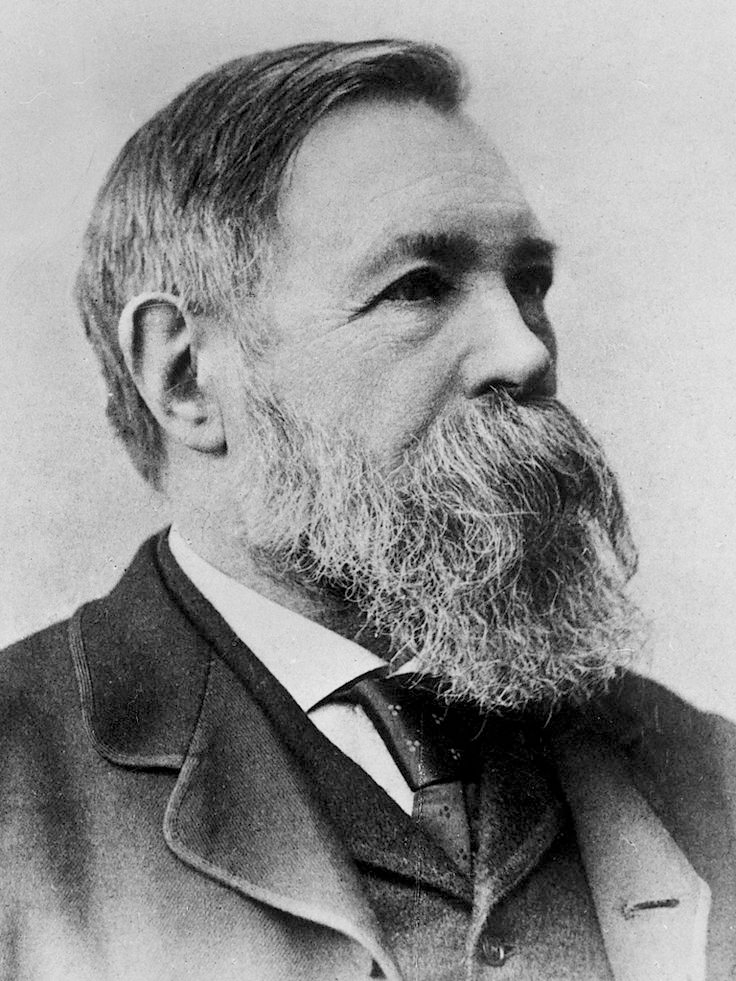Engels, Frederick, socialist, born in Barmen on Nov. 28, 1820, the son of a well-to-do manufacturer. Took up commerce, but already at an early age began propagating radical and socialist ideas in newspaper articles and speeches. After working for some time as a clerk in Bremen and serving for one year as an army volunteer in Berlin in 1842, he went for two years to Manchester, where his father was co-owner of a cotton mill.
In 1844 he worked for the Deutsch-Französische Jahrbücher published by Arnold Ruge and Karl Marx in Paris. In 1844 he returned to Barmen and in 1845 addressed communist meetings organised by Moses Hess and Gustav K?ttgen in Elberfeld. Then, until 1848, he lived alternately in Brussels and Paris; in 1846 he joined, with Marx, the secret Communist League, a predecessor of the International, and represented the Paris communities at the two League congresses in London in 1847. On the League's instructions, he wrote, jointly with Marx, the Communist Manifesto addressed to the "working men of all countries", which was published shortly before the February revolution [1848] (a new edition appeared in Leipzig in 1872).
In 1848 and 1849 E. worked in Cologne for the Neue Rheinische Zeitung edited by Marx, and after its suppression he contributed, in 1850, to the Politisch-oekonomische Revue. He witnessed the uprisings in Elberfeld, the Palatinate and Baden and took part in the Baden-Palatinate campaign as aide-de-camp in Willich's volunteer corps. After the suppression of the Baden uprising E. returned as a refugee to England and re-entered his father's firm in Manchester in 1850.
He retired from business in 1869 and has lived in London since 1870. He assisted his friend Marx in providing support for the international labour movement, which arose in 1864, and in carrying on social-democratic propaganda. E. was Secretary for Italy, Spain and Portugal on the General Council of the International. He advocates Marxian communism in opposition to both "petty bourgeois" Proudhonist and nihilistic Bakuninist anarchism. His main work is The Condition of the Working-Class in England (Leipzig, 1845; new edition, Stuttgart, 1892), which, although one-sided, possesses undeniable scientific value. His Anti-Dühring is a polemic of considerable size (2nd ed. Zurich, 1886). E.'s other published works include Ludwig Feuerbach and the End of Classical German Philosophy (Stuttgart, 1888), The Origin of the Family Socialism: Utopian and Scientific (4th ed., Berlin, 1891). E. also published Vols 2 and 3 of Karl Marx's Capital and the 3rd and 4th editions of Vol. I, and contributed many articles to the Neue Zeit.
Megathreads and spaces to hang out:
- ❤️ Come listen to music and Watch movies with your fellow Hexbears nerd, in Cy.tube
- 💖 Come talk in the New Weekly Queer thread
- 💛 Read and talk about a current topics in the News Megathread
- 💚 Come and talk in the Daily Bloomer Thread
- ⭐️ September Movie Nominations ⭐️
reminders:
- 💚 You nerds can join specific comms to see posts about all sorts of topics
- 💙 Hexbear’s algorithm prioritizes comments over upbears
- 💜 Sorting by new you nerd
- 🌈 If you ever want to make your own megathread, you can reserve a spot here nerd
- 🐶 Join the unofficial Hexbear-adjacent Mastodon instance toots.matapacos.dog
Links To Resources (Aid and Theory):
Aid:
Theory:



Can someone please please identify this font https://imgur.com/a/1jfHWJf ?
maybe Epoca Pro? If you were the one who took the screenshot, you can find the font by using inspect element
Since the red fash tankie mods deleted it for not being news I'll repost here.
The Tesco logo font or the other text? Tesco has its own proprietary font called Tesco Bold. The other text is likely something basic and default that your device uses. If it's android it might be in the Noto family or one of the Google fonts. Too basic to identify by eye for me though.
pretty sure the non-logo text is just Roboto
I thought it was Roboto at first, but the "d" seems to have a little curved tail on the lower right and Roboto just doesn't have that
The numbers and £ symbol seem like close matches. Roboto's 'd' does have a little tail, the apparent curve might be an antialiasing artifact.
yeah Roboto does look really close
It's 100% Roboto. Tail just looks weird because of anti-aliasing.